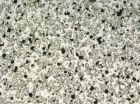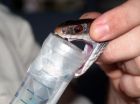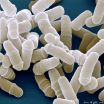(Press-News.org) Panama City, Panama – Integrated Ocean Drilling Program (IODP) Expedition 335 Superfast Spreading Rate Crust 4 recently completed operations in Ocean Drilling Program (ODP) Hole 1256D, a deep scientific borehole that extends more than 1500 meters below the seafloor into the Pacific Ocean's igneous crust – rocks that formed through the cooling and crystallization of magma, and form the basement of the ocean floor.
An international team of scientists led by co-chief scientists Damon Teagle (National Oceanographic Center Southampton, University of Southampton in the UK) and Benoît Ildefonse (CNRS, Université Montpellier 2 in France) returned to ODP Hole 1256D aboard the scientific research vessel, JOIDES Resolution, to sample a complete section of intact oceanic crust down into gabbros.
This expedition was the fourth in a series and builds on the efforts of three expeditions in 2002 and 2005.
Gabbros are coarse-grained intrusive rocks formed by the slow cooling of basaltic magmas. They make up the lower two-thirds of the ocean crust. The intrusion of gabbros at the mid-ocean ridges is the largest igneous process active on our planet with more than 12 cubic kilometers of new magma from the mantle intruded into the crust each year. The minerals, chemistry, and textures of gabbroic rocks preserve records of the processes that occur deep within the Earth's mid-ocean ridges, where new ocean crust is formed.
"The formation of new crust is the first step in Earth's plate tectonic cycle," explained Teagle. "This is the principal mechanism by which heat and material rise from within the Earth to the surface of the planet. And it's the motion and interactions of Earth's tectonic plates that drive the formation of mountains and volcanoes, the initiation of earthquakes, and the exchange of elements (such as carbon) between the Earth's interior, oceans, and atmosphere."
"Understanding the mechanisms that construct new tectonic plates has been a major, long-standing goal of scientific ocean drilling," added Ildefonse, "but progress has been inhibited by a dearth of appropriate samples because deep drilling (at depths greater than 1000 meters into the crust) in the rugged lavas and intrusive rocks of the ocean crust continues to pose significant technical challenges."
ODP Hole 1256D lies in the eastern equatorial Pacific Ocean about 900 kilometers to the west of Costa Rica and 1150 kilometers east of the present day East Pacific Rise. This hole is in 15 million year old crust that formed during an episode of "superfast" spreading at the ancient East Pacific Rise, when the newly formed plates were moving apart by more than 200 millimeters per year (mm/yr).
"Although a spreading rate of 200 mm/yr is significantly faster than the fastest spreading rates on our planet today, superfast-spread crust was an attractive target," stated Teagle, "because seismic experiments at active mid-ocean ridges indicated that gabbroic rocks should occur at much shallower depths than in crust formed at slower spreading rates. In 2005, we recovered gabbroic rocks at their predicted depth of approximately 1400 meters below the seafloor, vindicating the overall 'Superfast' strategy."
Previous expeditions to Hole 1256D successfully drilled through the erupted lavas and thin (approximately one-meter-wide) intrusive "dikes" of the upper crust, reaching into the gabbroic rocks of the lower crust. The drilling efforts of Expedition 335 were focused just below the 1500-meter mark in the critical transition zone from dikes to gabbros, where magma at 1200°C exchanges heat with super-heated seawater circulating within cracks in the upper crust. This heat exchange occurs across a narrow thermal boundary that is perhaps only a few tens of meters thick.
In this zone, the intrusion of magma causes profound textural changes to the surrounding rocks, a process known as contact metamorphism. In the mid-ocean ridge environment this results in the formation of very fine-grained granular rocks, called granoblastic basalts, whose constituent minerals recrystallize at a microscopic scale and become welded together by magmatic heat. The resulting metamorphic rock is as hard as any formation encountered by ocean drilling and sometimes even tougher than the most resilient of hard formation drilling and coring bits.
Expedition 335 reentered Hole 1256D more than five years after the last expedition to this site. The expedition encountered and overcame a series of significant engineering challenges, each of which was unique, although difficulties were not unexpected when drilling in a deep, uncased, marine borehole into igneous rocks.
The patient, persistent efforts of the drilling crew successfully cleared a major obstruction at a depth of 920 that had initially prevented reentry into the hole to its full depth of 1507 meters. Then at the bottom of the hole the very hard granular rocks that had proved challenging during the previous Superfast expedition were once more encountered. Although there may only be a few tens of meters of these particularly tenacious granoblastic basalts, their extreme toughness once more proved challenging to sample– resulting in the grinding down of one of the hardest formation coring bits into a smooth stump.
A progressive, logical course of action was then undertaken to clear the bottom of the hole of metal debris from the failed coring bit and drilling cuttings. This effort required the innovative use of hole-clearing equipment such as large magnets, and involved over 240 kilometers of drilling pipe deployments (trips) down into the hole and back onto the ship. (The total amount of pipe "tripped" was roughly equivalent to the distance from Paris to the English coast, or from New York City to Philadelphia, or Tokyo to Niigata). These efforts returned hundreds of kilograms of rocks and drill cuttings, including large blocks (up to 5 kilograms) of the culprit granoblastic basalts that hitherto had only been very poorly recovered through coring. A limited number of gabbro boulders were also recovered, indicating that scientists are tantalizingly close to breaking through into the gabbroic layer.
Expedition 335 operations also succeeded in clearing Hole 1256D of drill cuttings, much of which appear to have been circulating in the hole since earlier expeditions.
"We recovered a remarkable sample suite of granoblastic basalts along with minor gabbros, providing a detailed picture of a rarely sampled, yet critical interval of the oceanic crust," Ildefonse observed. "Most importantly," he added, "the hole has been stabilized and cleared to its full depth, and is ready for deepening in the near future."
INFORMATION:
About IODP
The Integrated Ocean Drilling Program (IODP), is an international research program dedicated to advancing scientific understanding of the Earth through drilling, coring, and monitoring the subseafloor. The JOIDES Resolution is a scientific research vessel managed by the US Implementing Organization of IODP (USIO). CHIKYU is a drilling vessel operated by JAMSTEC/CDEX (Japan), and mission-specific platforms are supplied by ECORD (the European Consortium for Ocean Research Drilling). IODP is supported by two lead agencies: the US National Science Foundation (NSF) and Japan's Ministry of Education, Culture, Sports, Science and Technology (MEXT). Additional program support comes from ECORD, the Australian-New Zealand IODP Consortium (ANZIC), India's Ministry of Earth Sciences, the People's Republic of China (Ministry of Science and Technology), and the Korea Institute of Geoscience and Mineral Resources.
Useful Websites:
For more information about IODP Expedition 335, Superfast Spreading Rate Crust 4, visit http://iodp.tamu.edu/scienceops/expeditions/superfast_rate_crust.html.
For more information about the JOIDES Resolution, visit www.joidesresolution.org.
For more information about the Integrated Ocean Drilling Program, visit www.iodp.org.
Media Contacts:
Sarah Saunders
Consortium for Ocean Leadership, Washington DC, USA
ssaunders@oceanleadership.org
+1-202-448-1239
Miyuki Otomo
Integrated Ocean Drilling Program Management International, Inc. (IODP-MI), Tokyo, Japan
motomo@iodp.org
+81-3-6701-3188
Heavy metal meets hard rock: Battling through the ocean crust's hardest rocks
2011-06-30
ELSE PRESS RELEASES FROM THIS DATE:
Debenhams Reveals British Tourists are Marking Their Territory on the Beach
2011-06-30
Debenhams, the high street store, has revealed that super-sized beach towels, able to occupy extra room on crowded shores and sun loungers are soaring in popularity.
Customers are using them to mark out more territory during holidays, providing a better defence against incursions from rival tourists fighting for space in the most popular resorts.
The new towels are up to 65 per cent bigger than normal, and designed using distinctive, bold, bright colours, making it obvious that the space is already occupied, even when the owner isn't there.
Debenhams spokeswoman, ...
Russell Investments Launches New Online Information Suite
2011-06-30
Russell Investments has launched a new dedicated website specifically for retail financial advisers.
The new online portal, available direct from the Russell Investments UK homepage, brings together the most relevant investment information from Russell's extensive range of detailed and unbiased industry analysis and allows financial advisers to cut through the noise to hone in on the topics which are important to them.
Alongside this, advisers will be able to quickly navigate through Russell's tools and investment services which can help them get under the bonnet ...
Antivenom against lethal snake gives hope to developing countries
2011-06-30
Researchers from the Australian Venom Research Unit (AVRU) at the University of Melbourne have collaborated with scientists from the University of Papua New Guinea and the University of Costa Rica, to develop new antivenom against the lethal Papuan taipan.
The preclinical studies of this antivenom have been published in the international journal PLoS Neglected Tropical Diseases.
Around 750 people are bitten in PNG each year. PhD candidate David Williams from AVRU, who coordinated the project in PNG, said snakebite is a neglected public health problem compounded by antivenom ...
Prudential Reveals Retirement Income Gender Gap is GBP6,500 a Year
2011-06-30
Prudential has announced that men retiring in 2011 expect to receive 50 per cent more pension income than women, according to new Prudential's Class of 2011 research.
Prudential's Class of 2011 research surveyed people planning to retire this year and found that the retirement income gender gap is GBP6,500. The average woman retiring this year expects an annual income of GBP12,900 compared with an average expected male income of GBP19,400.
There is some good news for women though as the retirement income gender gap has shrunk since last year when Prudential's study ...
Many a mickle makes a muckle: How changes in animals' size and shape arise
2011-06-30
The transcription of genes is tightly controlled, with a bewildering array of regulatory DNA sequences interacting with a similarly large number of proteins and other factors to determine which genes are active when and where. Understanding how it all works has challenged countless molecular biologists over the past decades but we are now starting to make significant progress. Even so, we have scarcely begun to understand how the entire complexity evolves to give differences in the size and shape of organisms. Exciting new findings are now reported by the group of David ...
elephant.co.uk Reveals Young Men Have More Expensive Car Crashes
2011-06-30
elephant.co.uk has revealed that while many men like to think they are the superior gender when it comes to driving, new research from the car insurance specialist shows men have bigger crashes that cost more money than women.
elephant.co.uk looked at more than 200,000 claims and found young men in particular have more expensive crashes. Accidents involving men aged under 25 cost on average 15% more than those involving women of the same age. In fact, the cost of accidents involving male drivers of all ages is 6% higher than accidents involving women.
To help improve ...
Using DNA in fight against illegal logging
2011-06-30
Advances in DNA 'fingerprinting' and other genetic techniques led by Adelaide researchers are making it harder for illegal loggers to get away with destroying protected rainforests.
DNA fingerprinting for timber products has grown in international recognition due to research led by the University of Adelaide that traces individual logs or wood products back to the forests where they came from.
Professor Andrew Lowe, Director of the University's Australian Centre for Evolutionary Biology and Biodiversity, and Dr Hugh Cross, Molecular Biologist at the State Herbarium ...
British Airways Launches New Flights to Faro and Malaga Direct from London City
2011-06-30
British Airways has announced the launch of two new routes to Faro and Malaga and added more frequency to the popular destinations of Nice, Palma and Ibiza. This means that British Airways now offers 39 leisure flights per week for this summer from London City Airport to top sun destinations at the height of the season.
The four times a week flights to Faro and the three times a week flights to Malaga are now both in operation and will operate year round.
The existing Nice service has been increased to double daily flights from May until September, and from July to ...
TV food advertising increases children's preference for unhealthy foods
2011-06-30
Researchers at the University of Liverpool have found that children who watch adverts for unhealthy food on television are more likely to want to eat high-fat and high-sugar foods.
The study by researchers in the Institute of Psychology, Health and Society examined the food preferences of a group of 281 children aged six to 13 years old from the North West of England.
The children were shown an episode of a popular cartoon before being shown it again two weeks later. In each case, the cartoon was preceded by five minutes of commercials – one set showing toy adverts ...
New tasks attributed to Aurora proteins in cell division
2011-06-30
When a cell divides, the genetic information in the chromosomes must be passed on error-free to the daughter cells. Researchers at the Friedrich Miescher Laboratory in Tübingen are studying this process using fission yeast as a model organism. In cooperation with researchers at the University of Tübingen, they succeeded in attributing additional tasks to the Aurora enzymes, which were already recognized as important cellular tools for the reliable transmission of genetic information. Because uncontrolled cell division is a feature of tumours, Aurora enzyme inhibitors are ...



